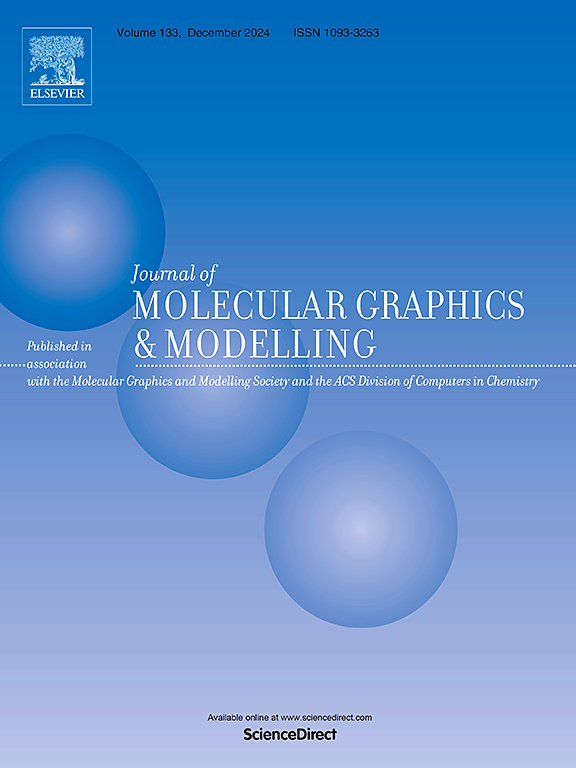Fosamprenavir and Tirofiban to combat COPD and cancer: A drug repurposing strategy integrating virtual screening, MD simulation, and DFT studies
IF 2.7
4区 生物学
Q2 BIOCHEMICAL RESEARCH METHODS
引用次数: 0
Abstract
Matrix metalloproteinases (MMPs) are involved in different pathophysiological conditions like cancer, COPD, asthma, and inflammatory diseases. Among these MMPs, macrophage metalloelastase is one of the prime targets for COPD, and cancer. Therefore, to combat such diseases, potent novel macrophage metalloelastase inhibitors can be considered. Here, the classification-based molecular modeling was performed on large data of macrophage metalloelastase inhibitors that identified dibenzofuran, and diphenyl ether groups as important substructures contributing towards potent macrophage metalloelastase inhibition. This information was further implicated in repurposing marketed drugs through fragment-based and molecular docking-based virtual screening with molecular dynamics (MD) simulation-based stability validation and DFT calculations. This study identified fosamprenavir and tirofiban as promising hits that can exhibit potent macrophage metalloelastase inhibition which was also validated by the MD simulation and DFT-based calculations. Therefore, this study not only revealed these repurposed drugs as effective macrophage metalloelastase inhibitors but also opened up a horizon in developing novel potent macrophage metalloelastase inhibitors for the management of cancer and COPD in the future.

福samprenavir和替罗非班对抗慢性阻塞性肺病和癌症:一种整合虚拟筛选、MD模拟和DFT研究的药物重新利用策略
基质金属蛋白酶(MMPs)参与不同的病理生理条件,如癌症、慢性阻塞性肺病、哮喘和炎症性疾病。在这些MMPs中,巨噬细胞金属弹性酶是COPD和癌症的主要靶点之一。因此,为了对抗这些疾病,可以考虑使用有效的新型巨噬细胞金属弹性酶抑制剂。本研究对巨噬细胞金属弹性酶抑制剂的大量数据进行了基于分类的分子建模,发现二苯并呋喃和二苯基醚基团是促进巨噬细胞金属弹性酶有效抑制的重要亚结构。这一信息进一步涉及通过基于片段和基于分子对接的虚拟筛选以及基于分子动力学(MD)模拟的稳定性验证和DFT计算来重新利用已上市药物。本研究确定fosamprenavir和替罗非班是有希望的打击,可以表现出有效的巨噬细胞金属弹性酶抑制,这也被MD模拟和基于dfs的计算验证。因此,本研究不仅揭示了这些重新定位的药物是有效的巨噬细胞金属弹性酶抑制剂,而且为未来开发新型有效的巨噬细胞金属弹性酶抑制剂用于癌症和慢性阻塞性肺病的治疗开辟了前景。
本文章由计算机程序翻译,如有差异,请以英文原文为准。
求助全文
约1分钟内获得全文
求助全文
来源期刊

Journal of molecular graphics & modelling
生物-计算机:跨学科应用
CiteScore
5.50
自引率
6.90%
发文量
216
审稿时长
35 days
期刊介绍:
The Journal of Molecular Graphics and Modelling is devoted to the publication of papers on the uses of computers in theoretical investigations of molecular structure, function, interaction, and design. The scope of the journal includes all aspects of molecular modeling and computational chemistry, including, for instance, the study of molecular shape and properties, molecular simulations, protein and polymer engineering, drug design, materials design, structure-activity and structure-property relationships, database mining, and compound library design.
As a primary research journal, JMGM seeks to bring new knowledge to the attention of our readers. As such, submissions to the journal need to not only report results, but must draw conclusions and explore implications of the work presented. Authors are strongly encouraged to bear this in mind when preparing manuscripts. Routine applications of standard modelling approaches, providing only very limited new scientific insight, will not meet our criteria for publication. Reproducibility of reported calculations is an important issue. Wherever possible, we urge authors to enhance their papers with Supplementary Data, for example, in QSAR studies machine-readable versions of molecular datasets or in the development of new force-field parameters versions of the topology and force field parameter files. Routine applications of existing methods that do not lead to genuinely new insight will not be considered.
 求助内容:
求助内容: 应助结果提醒方式:
应助结果提醒方式:


